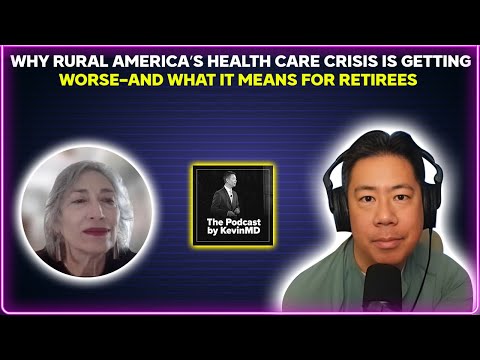Subscribe to The Podcast by KevinMD. Watch on YouTube. Catch up on old episodes!
We sit down with Banu Symington, a hematology-oncology physician, to explore a looming health care crisis affecting rural America. As more retirees move to rural communities, the number of health care providers is not keeping pace. Banu sheds light on the growing disparity between rural and urban health care access, the financial challenges threatening the survival of rural hospitals, and the flawed plan to turn these hospitals into triage-only facilities. We discuss the urgent need for sustainable solutions to prevent a worsening two-tiered health care system and ensure that rural patients have access to comprehensive medical care.
Banu Symington is a hematology-oncology physician.

Our presenting sponsor is DAX Copilot by Microsoft.
DAX Copilot, by Microsoft, is your AI assistant for automated clinical documentation and workflows. DAX Copilot allows physicians to do more with less and turn their words into a powerful productivity tool. DAX Copilot automates clinical documentation—making it available in the EHR within minutes—and clinical workflows, including referral letters, after-visit summaries, style and formatting customizations, and more.
70 percent of physicians who use DAX Copilot say it improves their work-life balance while reducing feelings of burnout and fatigue. Patients love it too! 93 percent of patients say their physician is more personable and conversational, and 75 percent of physicians say it improves patient experiences.
Discover AI-powered solutions for clinical documentation and workflows. Click here to see a 12-minute DAX Copilot demo.
VISIT SPONSOR → https://aka.ms/kevinmd
SUBSCRIBE TO THE PODCAST → https://www.kevinmd.com/podcast
RECOMMENDED BY KEVINMD → https://www.kevinmd.com/recommended
GET CME FOR THIS EPISODE → https://www.kevinmd.com/cme
I’m partnering with Learner+ to offer clinicians access to an AI-powered reflective portfolio that rewards CME/CE credits from meaningful reflections. Find out more: https://www.kevinmd.com/learnerplus
Transcript
Kevin Pho: Hi, and welcome to the show. Subscribe at KevinMD.com/podcast. Today, we welcome back Banu Symington. She is a hematology-oncology physician, and we’re going to talk about the challenges for retirees in terms of finding health care in rural America. Banu, welcome back to the show.
Banu Symington: Thank you so much, Kevin. Good to be here. Although I will admit I’m a little bit nervous today because we’re talking about something I am passionate about, but I don’t have a script or a prior essay to follow when we’re doing this.
Kevin Pho: So, I know that you wrote to me in an email that you wanted to talk about this, specifically about the looming health care crisis affecting rural America. So why don’t you lead off? Tell me why this is a problem.
Banu Symington: OK. First, a little about me. I’m a, as you know, a reluctant physician. I kind of stumbled into clinical medicine, and I’m also a big city girl raised and educated in Philadelphia. But through a series of serendipitous events—or some might call it fate—I’ve been a clinician practicing in ultra-rural or frontier Midwestern locations for most of my life. And I have, in that period of time, become passionate about protecting health care for rural patients, all of whom I’ve now adopted metaphorically as my patients. So, no offense meant to anyone when I say “my patients” in this context.
So, you know, the culture of medicine has changed, and nowhere is it more evident than in the rural setting, where there’s no longer a physician entrepreneur who can deliver an uninsured rancher’s baby and take a steer or half a steer as payment for his services. I hold the profit motive, which drives American health care, as responsible for these changes.
So right now, I’m a boots-on-the-ground practitioner. I’m a volunteer for various organizations, and I’m an avid reader. This gives me kind of a unique perspective on what real life as a patient and a provider in rural settings is. And it also gives me a perspective on what government officials and policy wonks are planning to do with this in the future. I can tell you that their plans aren’t going to work as a means of providing care to rural patients. They have a very rarified urban view of things, but I don’t have a way to stop the train that’s coming down the tracks at all patients, but particularly rural patients.
I don’t know if what we’re watching happen is a deliberate plan or neglect, but I think you’d agree that we’re looking at the destruction of medicine, and unfortunately, it’s going to affect rural areas first, but it’s coming for urban medicine too. Today, of course, I’m focusing on rural patients.
So, currently, about 20 percent of patients are in rural locations. This number is expected to rise as more retirees relocate to rural settings, either for economic reasons or because it’s a slower lifestyle. And less than 5 percent of doctors are located in rural areas—an even lower percentage of specialists. And through a variety of factors, this mismatch is going to get worse. Lots of publications about inferior health outcomes for rural patients; it’s been the subject of myriad scientific and health policy papers. We know there’s a mismatch between the number of patients and the number of providers. We know there’s an especially severe shortage of specialists. But this is getting worse, and we don’t really have a plan to deal with it.
The plan previously was to substitute advanced practice providers (APPs) for MDs and DOs, but this plan is failing. Much like physicians, APPs prefer to live in urban areas. And then the retirement of the old-time entrepreneurial practitioners in rural areas, which has been accelerated by both the COVID epidemic and by EMR and other mandated factors, the disinterest of newly trained physicians to move to rural areas, the closure of rural health care facilities, mostly due to financial factors—these are all combining so that we are looking at a future where there are either no rural health care facilities and hospitals, and patients will have to sort of self-navigate to urban facilities. Or, more likely, what I see—and I hear, because it’s not such a hidden agenda—is that rural hospitals will be turned into a giant emergency room and a triage facility, where patients will come to the hospital and just be shipped to a tertiary care facility.
Now, this may work for an acute MI or an acute pneumonia, but most illnesses are chronic, and they require ongoing chronic care. This is particularly true for cancer, which I’m a cancer physician, for kidney failure, hypertension, diabetes. These are all conditions that require ongoing care and interventions. While telehealth visits will work to provide some of this ongoing care, treatment of cancer and kidney failure require invasive ongoing interventions that really can’t be administered remotely. So, I’m feeling the impact of this particularly as a boots-on-the-ground cancer specialist in a frontier location.
Kevin Pho: Before we talk about solutions, let’s give a little bit more of a vivid picture in terms of the crisis, as you are literally there on the frontier. So, talk about some cases, talk about your practice that really illustrates this problem. Give us a case study or an example.
Banu Symington: So, Wyoming is a huge state area-wise, small state population-wise—less than half a million people—and there are about 15 health care facilities. Four of them in the past year have stopped providing OB services. So, patients are now traveling to my center to deliver their babies. It’s often 300 miles because there is no provider in Lander, Riverton, Kemmerer, or Rawlins who can do OB care.
More importantly, though, if you follow the Becker report, hospitals in rural states like Wyoming are just shutting down because of financial issues. They’re not getting reimbursed enough for the care. There’s a high rate of unreimbursed care. Many of these states didn’t expand Medicaid. So, when someone is sick, they don’t have an insurance program to cover their care. So, their hospitals are just shutting their doors and closing. And so, patients are having to travel greater distances. Three cancer centers in Wyoming have closed in the past year. So, that means the patients who already had to travel 150 miles for their care may now have to travel 300 miles for their care or get no care at all.
Kevin Pho: And as it relates to cancer, let’s say if a patient was undergoing chemotherapy and they have to travel hundreds of miles for that, just talk to my listeners who may not be familiar with a chemotherapy regimen, how that impacts their lives.
Banu Symington: Perfect. Perfect. So, a lot of regimens, many regimens, are every 21 days, but others are every 14 days, every seven days, three weeks, seven days out of 21, 28—you know, they’ll come in weekly three times out of a four-week period of time. Some treatments require seven continuous days of infusion. So, they have to get a pump put on every day for seven days, and they can’t—I mean, it’s impracticable for them to do that on an ongoing basis. So, many patients opt just not to have their cancer taken care of.
Kevin Pho: And have you seen the detrimental effects of that? Have you seen increased patient mortality because patients simply just can’t make that drive to get their chemotherapy?
Banu Symington: So, I’ll give an example of something that’s happening right now in my practice. There’s an acute leukemia patient who’s being treated in Salt Lake City, but she doesn’t even live in Rock Springs. She lives two hours further away from Salt Lake City than Rock Springs. I am not an acute leukemia specialist. That’s a very highly specialized field, and we’re negotiating—we’re trying to get her treated here under my care, even though that’ll be a two-hour drive every day, because if I refuse to do that, she’s withdrawing from care and she’s going to die.
I don’t feel particularly comfortable doing this because I’m not a leukemia specialist, but I don’t want her to withdraw from care. And so, I’m going to stretch to try to do that. But not every provider may be willing to make that stretch.
Kevin Pho: And the reason these smaller rural cancer centers are shutting down—is it purely financial? And before shutting down, I’m sure they tried to explore all the different avenues to stay viable before they made that decision to shut down. Is that correct?
Banu Symington: Correct. But one of the factors is it’s hard to recruit specialists to lead a cancer center in a rural facility, right? So, if you don’t have an oncologist in some form, you’re not going to be able to have a cancer center. But the second big driver is finances. I think we’ve talked about a for-profit health care issue that is active in urban settings. Insurance companies are requiring physicians like me, cancer doctors, to write chemotherapy orders for the chemotherapy to be delivered somewhere else to the patient. And these are private insurance companies, not Medicare, not Medicaid. And a lot of times, it’s a sad but true fact of medicine that sometimes we lose money on some patients. We make more money on other patients. And if you take away the patients on whom we can make a small profit, we’re only losing money. And those cancer centers are folding.
So, this move to require offsite infusions—insurance companies are removing many of the areas where cancer centers can make a small profit that will keep them afloat. And if you remove brown bagging, white bagging—I’m sure you’ve had guests talking about that—and this offsite infusion, all of it driven not because the insurance company cares about the patient’s quality of life, the quality of their care, or their experience, but only driven by the insurance company’s profit motive.

